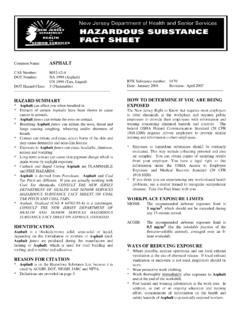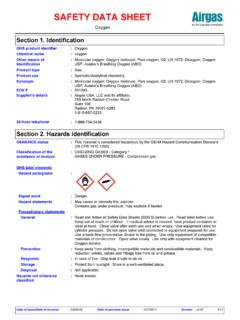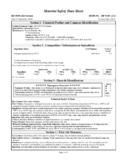Transcription of Material Safety Data Sheet Effective Date 06/28/2007 ...
1 Shell SC-70 Liquid AsphaltMSDS# 53472E Version Effective date 06/28/2007 Material Safety data Sheet According to OSHA Hazard Communication Standard, 29 CFR 1/10 Print date 06/29/2007 MSDS_US 1. Material AND COMPANY IDENTIFICATION Material Name : Shell SC-70 Liquid Asphalt Company : Shell Oil Products US P. O. Box 4453 Houston, TX 77210-4453 United States MSDS Request : 877-276-7285 Emergency Telephone Number Spill Information : 877-242-7400 Health Information : 877-504-9351 2. COMPOSITION/INFORMATION ON INGREDIENTS Distillates (petroleum), vacuum 70592-78-8 - % Distillates (petroleum), heavy naphthenic 64741-53-3 - % Distillates (petroleum), straight-run, middle 64741-44-2 - % Kerosine 8008-20-6 - % Residues (petroleum), vacuum 64741-56-6 - % Crude petroleum oil may contain trace levels of Hydrogen sulphide (H2S). Refer to chapter 16 for full text of EC R-phrases. 3. hazards IDENTIFICATION Emergency Overview Appearance and Odour : Black.
2 Semi-solid at ambient temperature. Liquid at high temperatures. Asphalt or rotten egg. Health hazards : Irritating to skin. High concentrations may cause central nervous system depression resulting in headaches, dizziness and nausea. Hydrogen sulphide (H2S), an extremely flammable and toxic gas, and potentially toxic sulphur oxides may be present. A component or components of this Material may cause cancer. Safety hazards : Hydrogen sulphide (H2S), an extremely flammable and toxic gas, and other hazardous vapours may evolve and collect in the headspace of storage tanks, transport vessels and other enclosed containers. Health hazards Inhalation : Hydrogen sulphide (H2S), an extremely flammable and toxic gas, and other hazardous vapours may evolve and collect in the headspace of storage tanks, transport vessels and other enclosed of high vapour concentrations may cause central nervous system (CNS) depression resulting Shell SC-70 Liquid AsphaltMSDS# 53472E Version Effective date 06/28/2007 Material Safety data Sheet According to OSHA Hazard Communication Standard, 29 CFR 2/10 Print date 06/29/2007 MSDS_US in dizziness, light-headedness, headache and nausea.
3 Skin Contact : Contact with hot Material can cause thermal burns which may result in permanent skin damage and/or blindness. Irritating to skin. Eye Contact : Hot product may cause severe eye and skin burns. Moderately irritating to eyes. Ingestion : Under normal conditions of use, this is not expected to be a primary route of exposure. Other Information : A component or components of this Material may cause cancer. Signs and Symptoms : Skin irritation signs and symptoms may include a burning sensation, redness, swelling, and/or blisters. Eye irritation signs and symptoms may include a burning sensation and a temporary redness of the eye. Breathing of high vapour concentrations may cause central nervous system (CNS) depression resulting in dizziness, light-headedness, headache, nausea and loss of coordination. Continued inhalation may result in unconsciousness and death. Aggravated Medical Condition : Pre-existing medical conditions of the following organ(s) or organ system(s) may be aggravated by exposure to this Material : Skin.
4 4. FIRST AID MEASURES General Information : DO NOT DELAY. Keep victim calm. Obtain medical treatment immediately. Inhalation : If inhalation of mists, fumes or vapour causes irritation to the nose or throat, remove to fresh air. If rapid recovery does not occur, obtain medical attention. Do not attempt to rescue the victim unless proper respiratory protection is worn. If the victim has difficulty breathing or tightness of the chest, is dizzy, vomiting, or unresponsive, give 100% oxygen with rescue breathing or Cardiopulmonary Resuscitation (CPR) as required and transport to the nearest medical facility. Skin Contact : Cover the burn area loosely with a sterile dressing, if available. Do not use solvent to remove the product. If contact with hot product, cool the burn area by flushing with large amounts of water. Do not attempt to remove anything from the burn area or apply burn creams or ointments. Cover the burn area loosely with a sterile dressing, if available.
5 Transport to the nearest medical facility for additional treatment. If persistent irritation occurs, obtain medical attention. It should be noted this product contracts on cooling. Remove contaminated clothing. Eye Contact : Flush eyes with water while holding eyelids open. Rest eyes for 30 minutes. If redness, burning, blurred vision, or swelling persist, transport to the nearest medical facility for additional treatment. If persistent irritation occurs, obtain medical attention. Ingestion : In general no treatment is necessary unless large quantities are swallowed, however, get medical advice. Under normal conditions of use, this is not expected to be a primary route of exposure. Advice to Physician : If removal is attempted, mineral oil (not mineral spirits) or a Shell SC-70 Liquid AsphaltMSDS# 53472E Version Effective date 06/28/2007 Material Safety data Sheet According to OSHA Hazard Communication Standard, 29 CFR 3/10 Print date 06/29/2007 MSDS_US mineral oil based ointment may be applied to help soften the product to facilitate removal.
6 Hydrogen sulphide (H2S) - CNS asphyxiant. May cause rhinitis, bronchitis and occassionally pulmonary oedema after severe exposure. CONSIDER: Oxygen therapy. Consult a Poison Control Centre for guidance. 5. FIRE FIGHTING MEASURES Clear fire area of all non-emergency personnel. Flash point : 121 C / 250 F Specific hazards : Material will not burn unless preheated. Extinguishing Media : Alcohol-resistant foam, water spray or fog. Dry chemical powder, carbon dioxide, sand or earth may be used for small fires only. Protective Equipment for Firefighters : Wear full protective clothing and self-contained breathing apparatus. Exposure to decomposition products may be a hazard to health. Additional Advice : Containers exposed to intense heat from fires should be cooled with large quantities of water. Do not use water in a jet. Evacuate the area of all non-essential personnel.
7 Keep adjacent containers cool by spraying with water. 6. ACCIDENTAL RELEASE MEASURES Avoid contact with skin, eyes and clothing. Remove contaminated clothing. Avoid contact with spilled or released Material . For guidance on selection of personal protective equipment see Chapter 8 of this Material Safety data Sheet . Protective measures : Contain residual Material at affected sites to prevent Material from entering drains (sewers), ditches, and waterways. Hot product should be handled so that there is no risk of burns. Use compressed air or fresh air respiratory equipment in confined spaces. Use appropriate containment to avoid environmental contamination. Prevent from spreading or entering drains, ditches or rivers by using sand, earth, or other appropriate barriers. Use appropriate containment to avoid environmental contamination. Prevent from spreading or entering drains, ditches or rivers by using sand, earth, or other appropriate barriers.
8 Clean Up Methods : For large liquid spills (> 1 drum), transfer by mechanical means such as vacuum truck to a salvage tank for recovery or safe disposal. Do not flush away residues with water. Retain as contaminated waste. Allow residues to evaporate or soak up with an appropriate absorbent Material and dispose of safely. Remove contaminated soil and dispose of safely. For small liquid spills (< 1 drum), transfer by mechanical means to a labelled, sealable container for product recovery or safe disposal. Allow residues to evaporate or soak up with an appropriate absorbent Material and dispose of safely. Remove contaminated soil and dispose of safely. Shell SC-70 Liquid AsphaltMSDS# 53472E Version Effective date 06/28/2007 Material Safety data Sheet According to OSHA Hazard Communication Standard, 29 CFR 4/10 Print date 06/29/2007 MSDS_US Additional Advice : This Material is covered by EPA's Comprehensive Environmental Response, Compensation and Liability Act (CERCLA) Petroleum Exclusion.
9 Therefore, releases to the environment may not be reportable under CERCLA. regulations may require reporting releases of this Material to the environment which exceed the reportable quantity (refer to Chapter 15) to the National Response Centre at (800) 424-8802. Under Section 311 of the Clean Water Act (CWA) this Material is considered an oil. As such, spills into surface waters must be reported to the National Response Centre at (800) 424-8802. 7. HANDLING AND STORAGE General Precautions : Avoid breathing vapours or contact with Material . Only use in well ventilated areas. Wash thoroughly after handling. For guidance on selection of personal protective equipment see Chapter 8 of this Material Safety data Sheet . Avoid contact with hot liquid to prevent thermal burns. Handling : Avoid contact with skin, eyes, and clothing. Do not breathe mists, fumes or vapours from heated product. Ensure adequate ventilation when using. Surfaces that are sufficiently hot may ignite liquid Material .
10 The inherent toxic and olfactory (sense of smell) fatiguing properties of hydrogen sulphide require that air monitoring alarms be used if concentrations are expected to reach harmful levels such as in enclosed spaces, heated transport vessels and spill or leak situations. If the air concentration exceeds 50 ppm, the area should be evacuated unless respiratory protection is in use. Use only in well-ventilated areas. Storage : Must be stored in a well-ventilated area, away from sunlight, ignition sources and other sources of heat. Keep tanks covered and containers tightly closed when not in use. Bulk storage tanks should be diked (bunded). Do not smoke in storage areas. Hydrogen sulphide may accumulate in tanks during long term storage at high temperatures. For this reason, tank vapour spaces should be regarded as hazardous. Storage Temperature: Refer to the Technical data Sheet for correct storage and handling temperatures.





